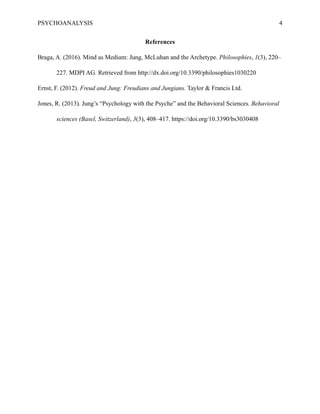Psych Essay
- 2. PSYCHOANALYSIS 2 Psychoanalysis Psychoanalysis is presented as a concept that investigates and explains what happens in the unconscious mind of human beings. Despite being a concept used in psychology, it has a background related to the culture of a certain group of people. Just the same way psychoanalysis can be used to study the state of mind by bringing what is in the unconscious mind to the conscious; it can also state the dynamics of culture (Ernst, 2012). The first piece of information that one can learn from the concepts presented by Freud and Jung is that psychoanalysis heavily depends on imagery and symbolism (Jones, 2013). The analysis of symbols within a specific piece of art determines the extent to which the culture of the people operates. The relationship between psychoanalysis and history is also a piece of information that one can learn from the works of Freud and Jung. The differences that exist between the works of Freud and Jung are important sources of knowledge that one also notes when going through the article (Ernst, 2012). The two opposing sides provide insights into different thoughts that can explain the unconscious mind instead of having one source of information. While Freud argues that whatever is kept in the unconscious mind is specifically based on a person’s past experiences, Jung argues that a person’s future can also impact today’s thoughts (Jones, 2013). The Jungian theory argues that childhood experiences do not have a lot of impacts on the current state of mind that a person has. Another concept that they argue about was libido energy. According to Freud, he considered it as sexual energy. At the same time, Jung considered it generalized psychic energy that could also motivate an individual spiritually, creatively, and intellectually. Third Reich and Psychoanalysis
- 3. PSYCHOANALYSIS 3 Adolf Hitler’s reign was characterized by a high level of hatred and disregard for the Jewish psychoanalysts. This period marked a duration when a concept that Freud started faced opposition from the government. Jewish researchers focusing on the concept were faced with hostility and forced to fly to exile. The decision by Hitler to do away with the Jewish psychoanalysts after he received information from apologetic historians who appreciated the working, he was doing with science (Braga, 2016). Hitler felt that criticism from the other researchers was not healthy and would eventually divide the people based on ideologies. The first political standing of psychoanalysis that one can note in the article is the beliefs that the Nazis had under the rule of Hitler. By studying the factors that made the Nazis think in the manner they did, the psychoanalysts would develop ways of changing their minds. Since Hitler was focused on accomplishing his mission, he had to do away with them. Psychoanalysis also addressed the military reasoning and the Nazis’ thoughts about the Jews and people from other races (Braga, 2016). Although they did not express them at first, the Nazis could be seen as people who were passionately against the presence of the Jews in Germany. The non-Jewish figures that joined in the condemnation of how the Jews were being treated were led by their conscious minds on the value of humanity (Ernst, 2012). They believed that every person had the right to air their views without any interference from the government. Those that joined the government in suppressing the Jews focused on the importance of having a country that did not have divergent views.
- 4. PSYCHOANALYSIS 4 References Braga, A. (2016). Mind as Medium: Jung, McLuhan and the Archetype. Philosophies, 1(3), 220– 227. MDPI AG. Retrieved from http://dx.doi.org/10.3390/philosophies1030220 Ernst, F. (2012). Freud and Jung: Freudians and Jungians. Taylor & Francis Ltd. Jones, R. (2013). Jung’s “Psychology with the Psyche” and the Behavioral Sciences. Behavioral sciences (Basel, Switzerland), 3(3), 408–417. https://doi.org/10.3390/bs3030408



